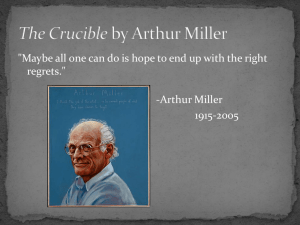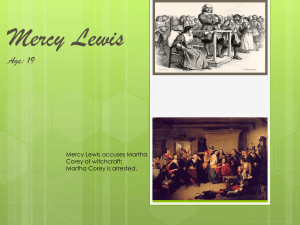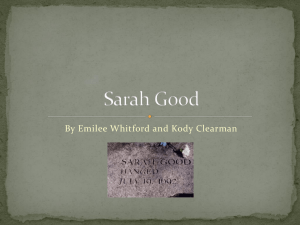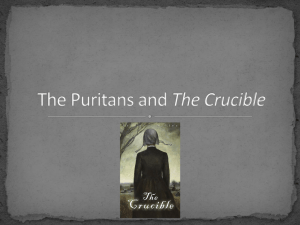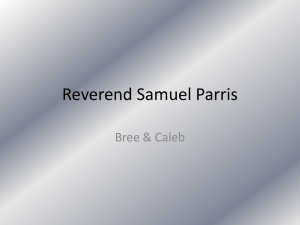Crucible Introduction ppt
advertisement
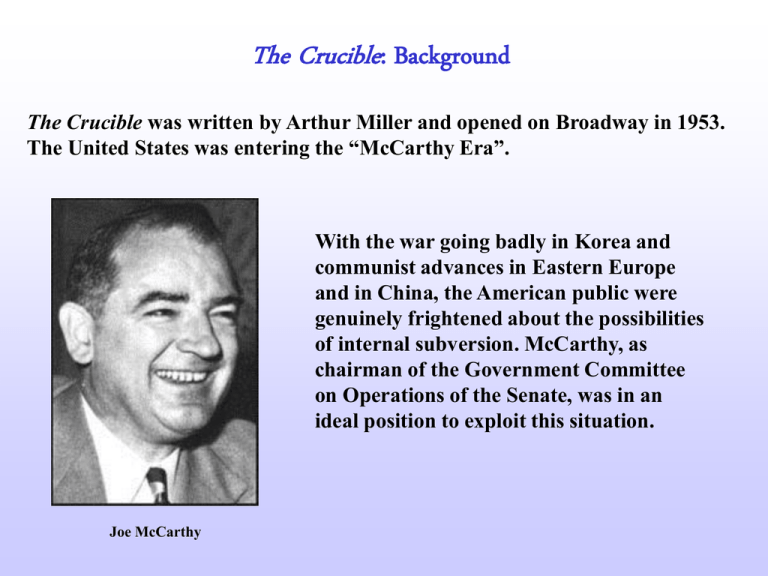
The Crucible: Background The Crucible was written by Arthur Miller and opened on Broadway in 1953. The United States was entering the “McCarthy Era”. With the war going badly in Korea and communist advances in Eastern Europe and in China, the American public were genuinely frightened about the possibilities of internal subversion. McCarthy, as chairman of the Government Committee on Operations of the Senate, was in an ideal position to exploit this situation. Joe McCarthy McCarthy investigated various government departments and questioned a large number of people about their political past. Some people lost their jobs after they admitted they had been members of the Communist Party. McCarthy made it clear to the witnesses that the only way of showing that they had abandoned their left-wing views was by naming other members of the party. This witch-hunt and anti-communist hysteria became known as McCarthyism or The Red Scare. McCarthy promoted unfounded accusations and suspicions of communism in many quarters, most prominently within the entertainment industry through the House Un-American Activities Committee (HUAC). HUAC investigated communism within Hollywood, calling a number of playwrights, directors and actors known for left-wing views to testify. Some of these, including film director Elia Kazan, testified for the committee to avoid prison sentences, but the Hollywood Ten, a group of entertainers, refused to testify and were convicted of contempt and sentenced to up to one year in prison. The Rosenbergs were executed as Communist spies during the McCarthy era Over three hundred other entertainers were placed on a blacklist for possible communist views and were thus forbidden to work for major Hollywood studios (many of these were writers who worked under pseudonyms at the time, including Dalton Trumbo and Michael Wilson). Arthur Miller was one of these blacklisted. The blacklist prevented these men from receiving screen credit during this time, until actor Kirk Douglas pushed for Trumbo to receive screen credit for his adaptation of Spartacus for Stanley Kubrick in 1960, thus finally breaking the blacklist. Arthur Miller (left) and Charlie Chaplin (right) were both called by HUAC ARTHUR MILLER: A Brief Biography Arthur Miller was born on October 17, 1915 in New York City. He was the son of a women’s clothing company owner who lost his business in the Depression; the family was forced to move to a smaller home in Brooklyn. He began writing at a very early age and by the time he graduated from the University of Michigan, he had begun to receive recognition as a playwright. His play All My Sons (1947) received the Drama Critics’ Circle Award and his play Death of a Salesman (1949) won the Pulitzer Prize. In 1953, Miller wrote The Crucible. Miller was concerned about what was happening in the United States where the “Red Scare”, initiated and fuelled by Senator Joe McCarthy, had Americans frightened of their neighbours. In order to vocalize his criticism, he selected an era in American history—the Salem Witch trials of 1692—which paralleled the McCarthy era Miller was refused a passport by the State Department to attend the opening of The Crucible in Brussels in 1954. The reason given was, “the applicant was suspected of being a supporter of the Communist movement.” He was called upon to testify before the Committee on Un-American Activities, but refused to “name names”. He was convicted of contempt of Congress in 1956. (He also married Marilyn Monroe in 1956!) The conviction was overturned by a higher court in 1958. Miller’s characters struggle with power conflicts, personal and social responsibility, the repercussions of past actions, and the conflict between hope and guilt. He once said he thought theatre could “change the world”. The Crucible The Crucible is a play about religious and political repression. Dissenters are rooted out, conformity is enforced. In Salem, a group of young girls had begun accusing various townspeople of witchcraft. As in the case of being accused of being a communist, the accused in Salem had a difficult time proving their innocence. As a result, 19 of the accused died on the gallows, one was “pressed” to death and many others died in jail. The examination of a witch in Salem Miller used actual historical events and people as the basis of his play. He wrote: No one can really know what their lives were like. Their creed forbade anything resembling “vain enjoyment”. They did not celebrate Christmas and a holiday from work meant only that they must concentrate even more on prayer. Salem was peopled by Puritans who were very religious and strict. They had come to Massachusetts to escape religious persecution in England. The Salem Environment The seeds of the hysteria that afflicted Salem Village, Massachusetts were sown in January 1692 when a group of young girls began to display bizarre behavior. The tight-knit community was at a loss to explain the convulsive seizures, blasphemous screaming, and trance-like states that afflicted the youngsters. The physicians called in to examine the girls could find no natural cause of the disturbing behavior. If the source of the affliction was not attributable to a physical malady, the community reasoned that it must be the work of Satan. Witches had invaded Salem. The girls’ odd behavior was traced to the home of Reverend Parris. His daughter Betty had gone into a trance for which the doctor had no explanation. Reverend Parris Parris organized prayer meetings and days of fasting in an attempt to alleviate Betty's symptoms. Parris did what he could to support Betty and other seemingly afflicted girls, including beating his servant, Tituba, into confessing, and fanning the flames of witchcraft suspicions from his pulpit. Once the witchcraft hysteria ran its course, dissatisfaction with Parris grew and intensified New Englanders did not invent belief in witchcraft. The first Papal Bull against witchcraft was issued in the 15th century, and in England three separate acts were directed against witches over the next 200 years, making witchcraft a felony, without benefit of clergy. •Witches could not shed tears •They were marked by the Devil—”witchmarks” •They floated when given the “swimming test” •They, with the Devil’s aid, could cause love or hate •They transferred diseases from person to person •They drove men and women crazy •They raised tempests •They murdered by means of waxen images or voodoo dolls •They haunted houses •They caused men and women to be possessed by demons •They could send their spirits out to their “familiars” The hanging of Bridget Bishop Villagers were accused and condemned by virtue of someone’s testimony that he or she had been “afflicted”. No actual proof other than someone’s accusation was required. Often the accused were asked to “name names” of others associated with the Devil (similar to the McCarthy trials).. The trial of George Jacobs Girls at the trial The hanging of George Burroughs A Scene from one of the trials Many of the accusations were made by Abigail Williams. In the play, Miller creates a relationship between Abigail and John Proctor in order to explain why she accused so many people. An accusation put forth by Abigail Williams Some who died in Salem… One of the gravestones in the Salem memorial REBECCA NURSE O Christian Martyr Who for Truth could die When all about thee Owned the hideous lie! The world, redeemed from superstition's sway, Is breathing freer for thy sake today. --Words written by John Greenleaf Whittier and inscribed on a monument marking the grave of Rebecca Nurse, one of the condemned "witches" of Salem. THE MAN OF IRON Giles Corey was a wizard strong, a stubborn wretch was he; And fit was he to hang on high upon the locust tree. So, when before the Magistrates for trial he did come, He would no true confession make, but was completely dumb. "Giles Corey," said the Magistrate, "What hast thou here to plead To those who now accuse thy sould of crime and horrid deed?" Giles Corey he said not a word, no single word spoke he. "Giles Corey," said the Magistrate, "We'll press it out of thee." They got them then a heavy beam, then laid it on his breast; They loaded it with heavy stones, and hard upon him pressed. "More weight," now said this wretched man. "More weight!" again he cried; And he did no confession make, but wickedly he died. --Anonymous (early 18th century Giles and Martha Corey This is the gravestone of John Proctor, the protagonist of The Crucible.





